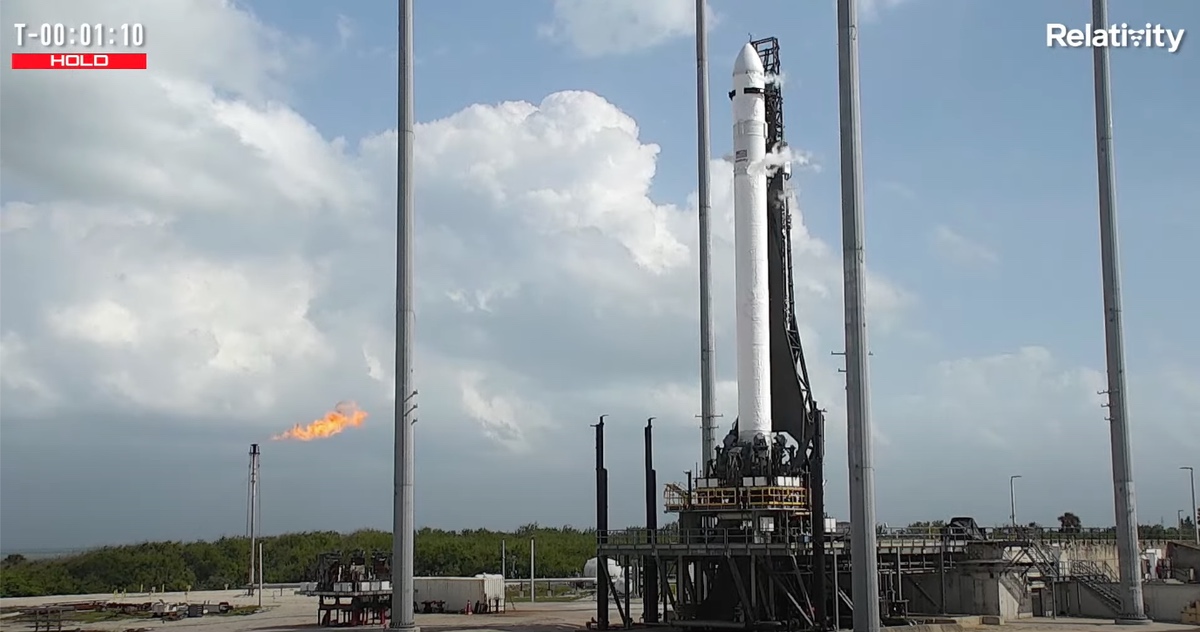Products You May Like
WASHINGTON — Relativity Space will wait at least three days before making its next attempt to launch its Terran 1 rocket after propellant temperature issues scrubbed its first launch attempt March 8.
Relativity was counting down to the inaugural launch of its Terran 1 rocket from Cape Canaveral’s Launch Complex 16 when an automated abort was triggered at T-70 seconds at about 2:45 p.m. Eastern. The three-hour launch window opened at 1 p.m. Eastern but the company had pushed back the launch to provide more time to get the rocket’s propellants at the right temperatures.
The abort, the company said, was triggered by liquid oxygen temperatures in the rocket’s upper stage that were out of limits. The company reset for another launch attempt at 3:45 p.m. Eastern, but scrubbed the launch for the day more than 20 minutes before the scheduled liftoff.
The company said later it scrubbed the launch “due to exceeding launch commit criteria limits for propellant thermal conditions on stage 2.” It later rescheduled the launch for March 11, again in a three-hour window that opens at 1 p.m. Eastern.
The three-day slip, the company explained, is because of time needed to prepare the rocket’s fuel, methane. “When using liquid natural gas, the methane needs time to get to the right concentration. This is why our next attempt will be a few days from now,” the company tweeted.
If successful, Terran 1 would be the first rocket to reach orbit that uses methane fuel. A privately developed Chinese rocket that uses methane fuel, Landspace’s Zhuque-2, launched in December but failed to reach orbit. Both SpaceX’s Starship and United Launch Alliance’s Vulcan Centaur use methane fuel and are slated to make their first orbital launch attempts within the next two months.
Relativity, though, has tempered expectations about the first Terran 1 launch. The mission, called “Good Luck, Have Fun,” is not carrying any satellite payloads. Instead, it will place into a roughly 200-kilometer orbit the upper stage, which contains inside its nose cone a metal ring that was the first 3D-printed component produced by the company.
Tim Ellis, co-founder and chief executive of Relativity, said in a series of tweets March 7 that a key aspect of the flight will be to demonstrate that the rocket, which is 85% by mass made of 3D-printed components, can handle the rigors of launch. That includes surviving “Max-Q”, or maximum dynamic pressure, on the rocket a little more than a minute after liftoff.
“But the key inflection in my mind is surpassing Max-Q, about 80 seconds into flight,” he wrote. “This will essentially prove the viability of using additive manufacturing tech to produce products that fly.”
The company has tested the ability of Terran 1 to survive those conditions in ground testing, he noted, “but in flight of course is the most visceral proof.”
Terran 1, capable of placing about 1,250 kilograms into orbit, is the latest entry into the small launch vehicle market, but it is also a precursor for the Terran R, a much larger vehicle intended to be fully reusable, unlike the expendable Terran 1. “Medium-heavy lift is clearly where the biggest market opportunity is for the remaining decade, with a massive launch shortage in this payload class underway,” Ellis wrote.
He suggested the company might shift immediately to the Terran R should Terran 1’s first launch fail, depending on the cause of the failure and the input Relativity gets from its customers. “Do they want us to continue down the path of producing more Terran 1’s to solve for those issues on this vehicle? Or, would like us to solve the remaining rocket science problems on the vehicle they are actually most interested in, Terran R?”
